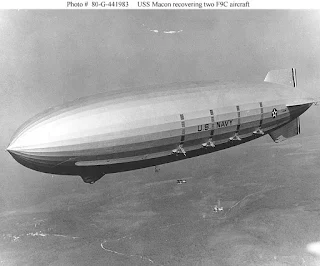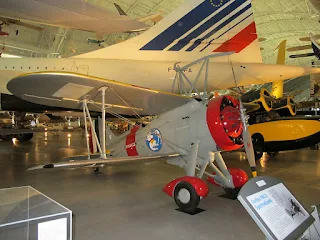As recently as
an article entitled “Blimps: New Life For An Old Idea”, appearing in the
October 2017 of the journal Aerospace
America (journal of the American Institute of Aeronautics and
Astronautics), was the potential rebirth of the Dirigible. The article cited
that TP Aerospace of Massachusetts was currently under contract to design a
blimp called Skybase for an unnamed client. The airship could
launch, recover and refuel five 90-kilogram drones equipped with cameras. The
article cites that their client is not alone, as Walmart has applied for a U.S.
patent in August 2017 for “gas-filled carrier aircrafts” from which unmanned
aircraft would deliver products to customers. Last year, Amazon patented a
similar idea.
To briefly quote the Aerospace
America article;
“Amazon and
Walmart are purposefully vague about their concepts, but airship industry
observers believe their proposed floating warehouses would need to be massive
to make sense economically and to accommodate the features described in their
patent documents. Walmart’s patent application describes an airship with a
kitchen, bunks and bathrooms for workers who sleep and work in shifts. Amazon’s
patent calls for the airship to carry equipment like forklifts and trolleys.
The Amazon patent does not say how big this floating warehouse would have to
be, but says a “shuttle” airship measuring 30 meters long would loft workers to
the warehouse and bring fresh inventory and new delivery drones.Amazon’s main airship would float above commercial airspace at 45,000 feet and on occasion descend to 2,000 feet to make advertising visible to people on the ground, according to the patent. Two airship experts questioned the viability of the concept, saying that to fly at 45,000 feet, an airship would need about six times more lifting gas than would be required to carry the same weight at 2,000 feet. Spokesmen for Amazon and Walmart declined to comment on the retailers’ proposed airships. Amazon’s Prime Air division has been flying drones for private delivery tests in the U.K.”
This reminded the author of another dirigible program conducted in the early 1930’s by the U.S. Navy, which culminated in the design, construction, and albeit brief operation of two massive dirigibles, the USS Akron (ZPS-4) and USS Macon (ZPS-5). Even with the use of helium instead of the earlier use of highly combustible hydrogen, the inherent limitations imposed by nominally benign weather conditions, proved deadly in storm conditions. This factor ultimately causing the destruction of both gigantic airships. Even prior to their respective crashes this resulted in severe constraints in the area of operation of the airships, and the execution of their intended primary mission of extended long range oceanic reconnaissance patrols. There had to have been a continuous radio watch for weather reports, as well as a barometric pressure gauge watch, analogous to the sight-glass on a boiler. Wonder how the crew handled clear air turbulence, apparently not too well. The cause of the crash of USS Macon off Big Sur, California in 1935 was wind shear, resulting in structural fracture of the un-strengthened ring supporting the upper tailfin.
An integral element in the total system design of these dirigibles was their use as airborne aircraft carriers in a program that briefly paralleled the much more successful development of purpose built ships as aircraft carriers, and the birth of modern United States Naval Aviation. The following drawing depicts the hangar bay arrangement in the USS Macon (ZPS-5). It was virtually identical in USS Akron (ZPS-4).
Built by the Goodyear Zeppelin Company, a subsidiary of the Goodyear Tire and Rubber Company, under Navy contract, both the Akron and the
Macon were magnificent engineering marvels of their day. Both were built in the
same time frame as the Empire State Building (1931). Each had an overall length
of 785 feet, a gas capacity of 6,850,000 cubic feet, a lift capacity 152,644
lbs., and a maximum speed of 75.6 knots. The hangar bay had the capability of
housing and operating 4 Sparrowhawk aircraft internally and a fifth aircraft
suspended on the dirigible’s portion of the “trapeze” launch and recovery
apparatus, but within the hangar.
Standing in back, left to right: Chief Boatswain William A. Buckley; Lieutenant (Junior Grade) George W. Campbell; Lieutenant (Junior Grade) John D. Reppy; Lieutenant (Junior Grade) Robert W. Larson; Lieutenant Howard L. Young; Lieutenant Harold B. Miller; Lieutenant (Junior Grade) Frederick N. Kivette; and Chief Machinist Emmet C. Thurman.
A critical
element in the execution of the extended long range ocean reconnaissance
mission of the USS Akron and Macon (including the F9C-2 aircraft) would be
reliable and effective communications. Not frequently discussed it suffices that historical documentation
on the subject is scarce.
Historians are
greatly indebted to the eminent Dr. Louis A. Gebhard for his research published
in Evolution of Naval Radio-Electronics
and Contributions of the Naval Research Laboratory, NRL Report 8300, dated 1979. Dr. Gebhard, as a young engineer, had jointed NRL in 1923 when it was formed. He rose to become Deputy Superintendent and head of the Radio Division. He held over 90 patents.
High Frequency
(HF) radio communications were not widely introduced into the U.S. Navy until the
1920’s, and early equipment relying on vacuum tubes, was simultaneously both
fragile and relatively heavy, compared to today.
Dr. Gebhard
cites one of the early and successful uses of HF radio was in the dirigible USS
Shenandoah (ZR-1) in its epic flight from Lakehurst, New Jersey to the west coast and
return in October 1924. The dirigible maintained continuous communications with
the Naval Research Laboratory and many radio stations, during its entire
voyage. Both transmitter and receiver were developed by the Naval Research
Laboratory, but no specific nomenclature is cited. The transmitter was capable of
both voice and keyed operation on 3332 kHz with a power output of 50 watts. The
receiver used three “N” (first successfully “miniaturized”) tubes and covered a
frequency range of 2000 to 6000 kHz. Portending the fate of both the Akron and
Macon, the USS Shenandoah crashed during a severe storm over Ohio in 1928. It’s
radio receiver was salvaged in good condition.
The first
specific aircraft radio-communications equipments giving effective and extended
service were developed 1922. Both fighter aircraft (SE1375, 500 watts, 570 to
750 kHz and patrol plane (SE1385, 500 watts, 300 to 570 kHz) were provided.
Given no further
significant technological advancements occurring in the intervening 10 year
period, both Akron and Macon would have used equipment evolved from the USS
Shenandoah installation or possibly Patrol Plane Communications Equipment, Type
SE 1385.
The radio
equipment in the F9C-2 aircraft was designated type XF and XH installation (“X”
- crystal controlled) Deemed satisfactory by the Navy, but not further identified or
described.
For decades, the same solid mahogany scale desk-top model has been built by various manufacturers in the Philippines. Unlike most modern diecasts or plastic scale models, quality control and accurate details have greatly varied on these aircraft. Recently a small inventory of these Sparrowhawks were made available on, of all things, Amazon. With prices widely ranging for essentially the identical model, planes from this group seemed like a real bargain. Both Bill Riley and myself, as well as any seasoned aviation historian, would be able to point out a series of inaccuracies, but overall it is a very nice 1:20 scale model, capturing a bygone colorful era of U.S. Naval Aviation.
A fascinating adjunct to this page is the long
term project of a retired computer engineer, Jack Clemens, who lives near
Moffett Field (formerly NAS Moffett) in Sunnyvale, California, has built a
fully operational radio controlled flying model of the USS Macon (ZPS-5). Two
years in construction it is 1:40 scale (1 inch to 1 meter, 20 feet in length,
and barely able to fit diagonally into his two car garage). Suffices to say
Jack Clemens is a very serious and accomplished model builder. His first two
attempts ran into disasters paralleling the real dirigibles (including the
family cat and a wind storm), but the third time was a charm being completed in
2011. Note the similarity of the model's construction to that of the actual
airship. With both sincere gratitude and full acknowledgment to Mr. Clemens,
here are some photographs from his project and a full video, for those who may
be interested.
A video of the 1:40 scale
model USS Macon (ZPS-5) flying inside the real Macon's hangar at Moffett Field,
California.
Some videos from
vintage films of the USS Akron and USS Macon during construction and flight
operations.
Part 3 can be seen at the following site; https://www.youtube.com/watch?v=phYl4LCjsXo&t=35s+. (Author's note:As an observation regarding this final part, who ever the technical advisor was on the US Navy uniforms severely errored (specifically LCDR Wiley's cap device), and unfortunately it tends to cast some doubt on the overall credibility/accuracy of the rest of the segment.)




























No comments:
Post a Comment